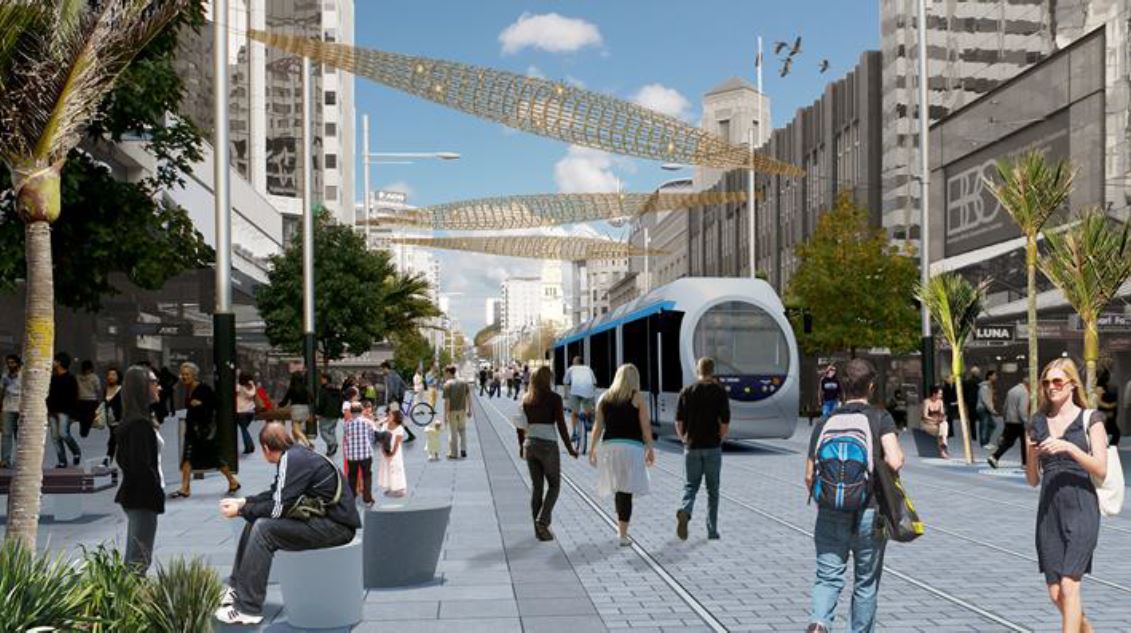A Tale of Two Cities
Milwaukee could learn from Auckland, which created a separate, non-profit authority to run the streetcar system.
No city has an exact twin. But I may have found as near a twin as Milwaukee is likely to get in the city of Auckland, New Zealand. I’ve lived in metro Milwaukee since 1990 and have had extended stays in New Zealand since 2013. In looking at a “twin,” we in Milwaukee might draw a lesson or two about ourselves, including where we’ve come from and where we might want to head, especially vis-à-vis streetcar service.
Auckland was founded in 1840, Milwaukee in 1846. Auckland’s metro population is more than 1.52 million, while metro Milwaukee’s four-county population is about 1.57 million. Auckland isn’t the capital of New Zealand (Wellington is) but it’s New Zealand’s financial and commercial capital, just as Milwaukee is Wisconsin’s. Milwaukee faces Lake Michigan; Auckland faces the Pacific to the east and the Tasman Sea to the west. Streetcar service was discontinued in Auckland in 1956 and in Milwaukee in 1951. After 1956 Auckland until about 2000 followed pro-automobile policies. Even now investment in urban freeways is occurring in Auckland. Milwaukee’s situation is comparable, with heavy recent and current investment – the rebuilds of the Marquette, Mitchell, and Zoo interchanges come to mind – in freeways.
The topic of streetcars entered public discussion in Auckland just since mid-January when Auckland Transport (the transport enterprise arm of Auckland government) proposed considering a ‘tram’ (i.e. a streetcar) service on Auckland’s main thoroughfare, Queen Street. This proposal, while it came like a bolt out of the blue, was in no sense foreign to New Zealand, not the way Mr. Barrett’s streetcar proposal may seem foreign to Milwaukee.
Kiwis hedged their bets under both National (conservative) and Labour (liberal) governments. The Nationalists sponsored the electrification of the North Island Main Trunk Railway as part of a “Think Big” effort to reduce dependence on imported petroleum. Apparently transcending partisan lines, about 15 years ago the powers-that-be in Auckland decided that public transport needed an infusion of new investment, not least to cope with prospective population growth. A multi-modal strategy supplanted Auckland’s previous auto-focused strategy.
Among other things, a decision was made to relocate the head station of Auckland’s metropolitan (mainline) rail network to the abandoned central post office on Queen Street, right in the Central Business District (CBD). The Britomart Transport Centre, as it’s called, opened in 2003. In the following 10 years annual ridership on the metro rail network went from 2 million to 10 million. Subsequently that network has been undergoing electrification (to permit faster, quieter, cleaner train operations). Moreover Auckland’s current mayor is committed to building a so-called ‘City Rail Link’ (beyond Britomart) to better serve Auckland’s CBD and to enable the metro rail system to carry 20 to 30 million passengers annually.
Auckland politicians and the national politicians disagree on who should pick up the tab for the Link (Auckland’s population is a third of New Zealand’s population). But the Link is likely to be built, given the city’s growth prospects and its constricted, isthmus geography. Pro-highway interests are unlikely to derail the momentum, anymore than pro-streetcar forces in Milwaukee could thwart, say, the rebuilding of the Zoo Interchange. There’s only so much money available for big projects and in Auckland the greater momentum is now with metropolitan rail service.
My sense is that Mayor Barrett’s current efforts will bear some fruit, as opposed to prior, Sisyphean efforts. Milwaukee will finally get at least some rail-technology urban transport: namely, a streetcar service in the CBD. It will be very difficult to build on the streetcar core outside the CBD, because the predominant institutionalized interests and funding structures are geared for non-rail-technology projects.
But going forward perhaps Milwaukee can learn a thing or two from its near twin in New Zealand. Auckland Transport, an arm of Auckland’s government, functions as an enterprise, which in turn contracts with operators of bus services, the metro rail service, ferry services, as well as overseeing all Auckland roadways outside the State Highway network. In some ways Auckland Transport functions as a regional transport authority (RTA), an authority that Southeastern Wisconsin has been unable to form. In some ways it’s like a business enterprise.
With or without an RTA in metro Milwaukee, every effort should be made for the streetcar service to be run like an enterprise, rather than as a department within, say, Milwaukee city government. As an enterprise, especially as a legally incorporated (non-profit) enterprise, a streetcar service can be or is more likely able to be:
- Focused on acquiring and satisfying customers regardless of whether or not they’re Milwaukee citizens.
- Agile because less bureaucratic, able to enter contracts without the constraints of a governmental department.
- Less enmeshed in political issues having no relevance to its service (and therefore less likely to be held hostage to political horse-trading).
- More transparent because better defined, with financial results reportable through well-established (non-profit) business accounting practices.
- Able to engage “outsiders” on its board, a plus in any event, but even more so if there’s any hope of the streetcar service reaching beyond Milwaukee’s municipal boundaries.
Creating an enterprise structure is as important as identifying initial streetcar routes in founding a fruitful streetcar service.
Time will tell and others must now decide whether any of this will happen. Auckland has decided to give itself robust transportation options. Will Milwaukee begin to do likewise?
Tim Jorgenson is a former passenger-and-freight railway executive. He has kept a New Zealand blog while living there periodically in 2013, ’14, and ’15.
Op-Ed
-
Wisconsin Candidates Decry Money in Politics, Plan to Raise Tons of It
 Dec 15th, 2025 by Ruth Conniff
Dec 15th, 2025 by Ruth Conniff
-
Trump Left Contraceptives to Rot; Women Pay the Price
 Dec 8th, 2025 by Dr. Shefaali Sharma
Dec 8th, 2025 by Dr. Shefaali Sharma
-
Why the Common Council’s Amended Budget is Good Policy for Milwaukee
 Nov 20th, 2025 by Alds. Marina Dimitrijevic and Russell W. Stamper, II
Nov 20th, 2025 by Alds. Marina Dimitrijevic and Russell W. Stamper, II






















Does the city of Aukland have a minority, or in Australia’s case an indigenous, population of over 50% that is hyper-segregated, riddled in poverty, inundated with incarceration rates and a public education system that is constantly under attack and undermined by their elected officials?
Then Aukland is no twin city to Milwaukee.
Very interesting comments. I think a corporation independent of government, answering to stockholders, should run the system. Are there any willing investors.
Interesting concept. More interesting is the guy who thinks New Zealand and Australia are the same place.
Calling these two sister cities is a joke, first off you compared their metro area to our four county area to get the population numbers to come close, second nobody is foreseeing Milwaukee’s population to double. And just try to get this done here by a non-profit that wouldn’t use unionized government workers.
Paul, How is comparing these two metro areas a joke? The population number they used for Aukland’s metro area encompasses 1,800 square miles, whereas as the number for Milwaukee’s metro encompasses 1,400 square miles. Frankly, it’s a joke that Milwaukee’s metro population in this analysis (or any other) does not include Racine County. The MSA number for Milwaukee should count Racine, putting Milwaukee’s number closer to 1.8 million; the fact that Milwaukee’s MSA does not include Racine (and the commuting numbers are there to qualify, if Racine would just agree to be included) is a testament to how divisive this area can be when it comes to regional cooperation. There probably is not one other major MSA in the USA that does not include in its population figure a county directly adjacent to the primary county of the metro. Places like Minneapolis and Kansas City have these crazy bloated population numbers in part because the counties agreed to group together; those metro areas stretch on for endless farm land. Not the case with Milwaukee.
As a whole, Milwaukee is probably slightly larger than Aukland (really, we’re closer to 2,000,000 with the CSA numbers). The comparison is probably as fair as you’ll get with an international city.
S…City of Auckland is 426 square miles with a population of 1.4 million,
Paul, the number they used was for the metro region, not just the City. But if you insist. The City of Milwaukee is 96 square miles with 600,000 people. Milwaukee County is appx 1,000,000 people in 241 square miles (that is quite dense; indeed, even denser than the City of Auckland!). If you add Waukesha County, we’re talking about 1.4 million people in about 750 square miles. Do you dispute that the population figures for the “region” are similar? How could you? Do you dispute that the suburbs are extensions of the City of Milwaukee? The Milwaukee area has obviously grown from its heart, for most of those towns would just be small farm towns without the outgrowth of the area’s industrial and financial center. Why insist that Milwaukee is small? The small-mindedness of people in this region is fascinating. Its so unnecessary and such an impediment to the Milwaukee region realizing its potential.
S…Aucklands population is expected to double, seems like Milwakees is going the going the other way.
How is Milwaukee going the “other way”? It’s projected to increase (http://www.doa.state.wi.us/Documents/DIR/Demographic%20Services%20Center/Projections/FinalProjs2040_Publication.pdf) continuously through 2040. Even if Auckland is growing faster, that doesn’t mean the cities aren’t comparable in a number of other ways, including their current population (again, Milwaukee currently appears to be larger), transit histories, etc.; nor does it mean one city cannot be an example for another.
@Paul Milwaukee’s population is not expected to double, but it is not going “the other way.” In fact the first time in decades Milwaukee is growing again.
Dave, seems to be going up very slowly since 2010, the additional taxes that will come along with a streetcar project will probably stop that growth.
@Paul Yup, the population is going up, not down (which would be the other way). Further, even supposing the entire operating cost was put on the tax bill (which btw is not the plan) the impact to the overall city budget is very small. City budget $1.51 Billion… Operating cost about $3 million. I doubt this hurts growth, if anything it certainly helps growth.
Dave, where is the money going to come from to build this with all the extensions, the mayor will not tell us the total cost, which could be a billion dollars. Operating costs for the first loop is estimated to be $1.8 to $2 million, what will it be for the whole system the mayor has planned?
@Paul Well as has been mentioned by the Mayor future federal grants could pay for extensions. Grants in the form of New Starts, Small Starts, CMAQ, and TIGER for example (and even with a GOP controlled congress this program still lives on). And I’d expect, not sure if this has been said by anyone or not, that TIFs connected to projects along the line would be used for extensions, which by the way is exactly what TIF should be used for (public infrastructure). Operating costs will of course go up as the line gets longer (though not linearly as some costs such as the maintenance facility won’t be replicated again), but that bridge will be crossed when it happens (as is done with other transportation and infrastructure projects such as roads and the RiverWalk). Finally, it is quite possible, I’d say likely, that the increased values of properties plus new development along the line will make up for operating costs, and then some.